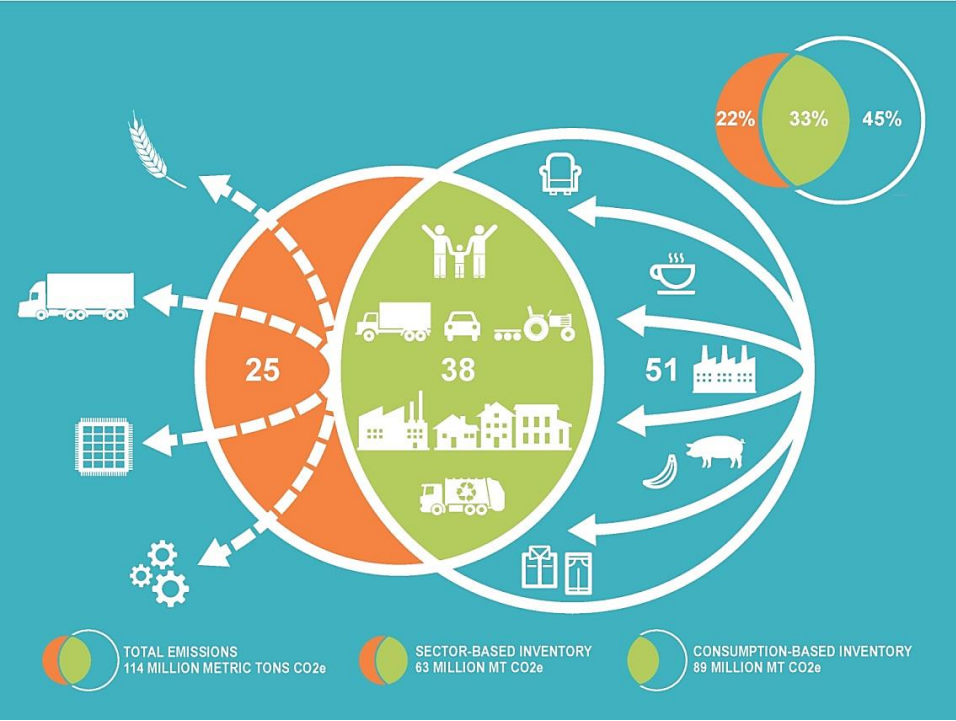Salem's Climate Action Plan outlines strategies to reduce greenhouse gas emissions and increase climate resilience. To track progress, sector-based inventory reports are conducted every two to five years. Salem’s first sector-based inventory was completed in 2019 using data from the 2016 survey. The most recent inventory (2021 Inventory of Community Greenhouse Gas Emissions) was completed in early 2023, used data from 2021.
Background
Greenhouse gas emissions are produced in the City of Salem every day from activities such as driving vehicles, heating homes, or cooking with natural gas. We also contribute to greenhouse gas emissions indirectly when we purchase goods or food manufactured in other places and transported to Salem. All these emissions come from human activities that contribute to climate change.
Acknowledging the different ways that we add to this global issue, the City has collected information about greenhouse gas emissions in two different ways.
Sector-based inventory: Emissions produced in Salem from areas such as transportation, and residential, commercial, and industrial building and energy sources, including electricity produced elsewhere but used in the city.
Consumption-based inventory: Emissions produced around the world due to Salem residents’ consumption of goods and services, including emissions associated with the production, transportation, supply chain, use, and disposal of those products.
The sector-based inventory is the traditional method for setting a goal and tracking emissions within a geographical area, such as Salem city limits, and is like the methods many other cities and countries use. The consumption-based inventory is a less common method and is increasingly being used by local governments to better understand how the choices and behaviors of individuals can impact climate change.
It is important to note that sector-based and consumption-based inventories are not additive, as there are areas of overlap. Instead, they are both pieces of the greenhouse gas emission picture. Emissions from Salem’s consumption-based inventory cannot be directly added to the sector-based inventory because some consumption occurs within the Salem city limits and therefore these emissions would be double-counted. The Venn Diagram below from the Oregon Global Warming Commission illustrates how the emissions inventories were different between Consumption-Based and Sector-Based.

Data for both methods were gathered from federal, state, and local sources, including utilities.
Sector-Based Inventory
The City's sector-based greenhouse gas inventory reports follow a traditional method used for setting goals and tracking emissions within a geographical area, the Salem city limits. Each has been prepared using the “Global Protocol for Community Scale Greenhouse Gas Emission Inventories” (GPC). The GPC is an internationally accepted method for sector-based greenhouse gas accounting that covers a range of emissions sources, including transportation, waste production, and energy use. The reports provide a snapshot of emissions from Salem’s residents, employees, and visitors undertaken within or originating from Salem city limits. They do not include greenhouse gas emissions related to the consumption of goods within Salem’s city limits that originated elsewhere.
2021 Inventory Results
In 2021, the City of Salem’s residents, businesses, employees, and visitors produced over 1.2 million metric tons of carbon dioxide equivalent (CO2e). This equates to roughly 6.94 metric tons of CO2e per capita. Of the six emissions source categories surveyed, mobile emissions – transportation – made up the majority (41 percent) of the CO2e produced. The second largest source of emissions (32%) was from residential energy use. This includes emissions produced through electricity generation as well as through fuel combustion (natural gas and other fuels) in our homes. 2021 Inventory of Community Greenhouse Gas Emissions.
Consumption-Based Inventory
The consumption-based inventory is a less common method that is increasingly being used by local governments to better understand how the choices and behaviors of individuals can impact climate change. It was prepared using methods similar to the Consumption-based Greenhouse Gas Emissions Inventory for Oregon. The method accounts for greenhouse gas emissions that we indirectly contribute through the purchase of goods or food manufactured in other places and transported to Salem, and from the use and disposal of those items. Specifically, for every good or service used, greenhouse gas emissions may be created from the production, transportation, wholesale or retail sales, consumer use, and eventual disposal of the purchased item or service.
2016 Inventory Results
In 2016, City of Salem’s residents, businesses, and organizations contributed approximately 4.2 million metric tons of carbon dioxide equivalent through consumption-based emissions. This means that individual choice and behavior overwhelmingly influence global emissions. The purchase and use of vehicles and parts is the largest source (29 percent) of emissions in the consumption-based inventory, while food and beverages are the second largest at 22 percent. Salem 2016 Consumption-Based Greenhouse Gas Inventory.
